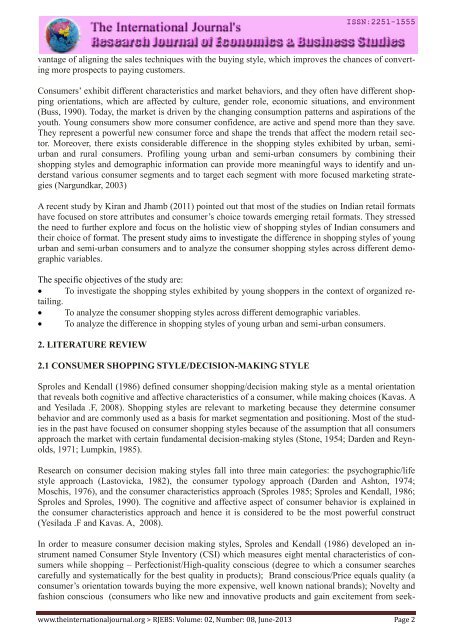Research Journal of Economics & Business Studies - RJEBS - The ...
Research Journal of Economics & Business Studies - RJEBS - The ...
Research Journal of Economics & Business Studies - RJEBS - The ...
- No tags were found...
Create successful ePaper yourself
Turn your PDF publications into a flip-book with our unique Google optimized e-Paper software.
vantage <strong>of</strong> aligning the sales techniques with the buying style, which improves the chances <strong>of</strong> converting<br />
more prospects to paying customers.<br />
Consumers’ exhibit different characteristics and market behaviors, and they <strong>of</strong>ten have different shopping<br />
orientations, which are affected by culture, gender role, economic situations, and environment<br />
(Buss, 1990). Today, the market is driven by the changing consumption patterns and aspirations <strong>of</strong> the<br />
youth. Young consumers show more consumer confidence, are active and spend more than they save.<br />
<strong>The</strong>y represent a powerful new consumer force and shape the trends that affect the modern retail sector.<br />
Moreover, there exists considerable difference in the shopping styles exhibited by urban, semiurban<br />
and rural consumers. Pr<strong>of</strong>iling young urban and semi-urban consumers by combining their<br />
shopping styles and demographic information can provide more meaningful ways to identify and understand<br />
various consumer segments and to target each segment with more focused marketing strategies<br />
(Nargundkar, 2003)<br />
A recent study by Kiran and Jhamb (2011) pointed out that most <strong>of</strong> the studies on Indian retail formats<br />
have focused on store attributes and consumer’s choice towards emerging retail formats. <strong>The</strong>y stressed<br />
the need to further explore and focus on the holistic view <strong>of</strong> shopping styles <strong>of</strong> Indian consumers and<br />
their choice <strong>of</strong> format. <strong>The</strong> present study aims to investigate the difference in shopping styles <strong>of</strong> young<br />
urban and semi-urban consumers and to analyze the consumer shopping styles across different demographic<br />
variables.<br />
<strong>The</strong> specific objectives <strong>of</strong> the study are:<br />
To investigate the shopping styles exhibited by young shoppers in the context <strong>of</strong> organized retailing.<br />
To analyze the consumer shopping styles across different demographic variables.<br />
To analyze the difference in shopping styles <strong>of</strong> young urban and semi-urban consumers.<br />
2. LITERATURE REVIEW<br />
2.1 CONSUMER SHOPPING STYLE/DECISION-MAKING STYLE<br />
Sproles and Kendall (1986) defined consumer shopping/decision making style as a mental orientation<br />
that reveals both cognitive and affective characteristics <strong>of</strong> a consumer, while making choices (Kavas. A<br />
and Yesilada .F, 2008). Shopping styles are relevant to marketing because they determine consumer<br />
behavior and are commonly used as a basis for market segmentation and positioning. Most <strong>of</strong> the studies<br />
in the past have focused on consumer shopping styles because <strong>of</strong> the assumption that all consumers<br />
approach the market with certain fundamental decision-making styles (Stone, 1954; Darden and Reynolds,<br />
1971; Lumpkin, 1985).<br />
<strong>Research</strong> on consumer decision making styles fall into three main categories: the psychographic/life<br />
style approach (Lastovicka, 1982), the consumer typology approach (Darden and Ashton, 1974;<br />
Moschis, 1976), and the consumer characteristics approach (Sproles 1985; Sproles and Kendall, 1986;<br />
Sproles and Sproles, 1990). <strong>The</strong> cognitive and affective aspect <strong>of</strong> consumer behavior is explained in<br />
the consumer characteristics approach and hence it is considered to be the most powerful construct<br />
(Yesilada .F and Kavas. A, 2008).<br />
In order to measure consumer decision making styles, Sproles and Kendall (1986) developed an instrument<br />
named Consumer Style Inventory (CSI) which measures eight mental characteristics <strong>of</strong> consumers<br />
while shopping – Perfectionist/High-quality conscious (degree to which a consumer searches<br />
carefully and systematically for the best quality in products); Brand conscious/Price equals quality (a<br />
consumer’s orientation towards buying the more expensive, well known national brands); Novelty and<br />
fashion conscious (consumers who like new and innovative products and gain excitement from seek-<br />
www.theinternationaljournal.org > <strong>RJEBS</strong>: Volume: 02, Number: 08, June-2013 Page 2

















